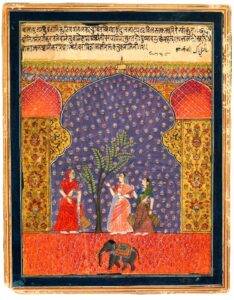Thumri is a prominent genre of North Indian classical vocal music that is known for its emotive and romantic content. It originated in the late medieval period and has since become a significant part of the Hindustani classical music tradition. Thumri is characterized by its lyrical expression, delicate ornamentation, and its ability to convey a wide range of emotions, particularly those related to love and human relationships. It often features graceful and sensuous melodies, making it a favorite among music enthusiasts for its aesthetic appeal. Thumri is deeply rooted in the concept of ragas, which are specific melodic frameworks used in Indian classical music. Different ragas evoke distinct moods and emotions. Thumri typically employs lighter ragas compared to the more complex and serious ragas used in classical dhrupad and khayal styles. Thumri has a flexible rhythmic structure, allowing for subtle rhythmic variations. It is often performed in a medium tempo (madhya laya) or slow tempo (vilambit laya), which provides space for expressive elaboration and ornamentation.
Bol-Baant is a technique used in thumri where the lyrics of a song are divided into syllables and rhythmically woven into the melody. It adds a playful and rhythmic aspect to the performance, creating intricate patterns of vocalization. Thumri is known for its intricate ornamentation, which involves adding decorative elements to the melodic phrases. These embellishments include meend (glides between notes), murki (quick melodic turns), and gamak (oscillations around a note), enhancing the lyrical and emotional aspects of the music. The primary focus of thumri is to convey the emotional content of the lyrics. Performers use a variety of techniques to evoke different emotions, such as yearning, longing, joy, and sensuality. The use of microtonal inflections and careful phrasing contributes to the emotional depth of the rendition.

Thumri often features poetic and storytelling lyrics that convey various themes, including love, separation, devotion, and daily life. The narrative quality of the lyrics enhances the emotional engagement with the audience. Thumri performances often include improvisational sections called “ang” and “upaj.” Ang refers to structured improvisation within the boundaries of the raga and composition, while upaj involves spontaneous elaboration that highlights the performer’s creativity. The rich and expressive genre of Indian classical music emphasizes lyrical beauty, emotional depth, and improvisational artistry. Its fusion of melody, rhythm, and emotional storytelling makes it a captivating and enchanting form of musical expression. The popular form of North Indian classical vocal music has had a notable influence on melodic instruments, especially sitar playing.
Thumri is known for its emotional and lyrical style of singing. Sitar players have adapted this melodic expressiveness into their playing, infusing their renditions with intricate ornamentations, slides, and bends that mimic the vocal nuances of thumri singing. This enhances the emotive quality of the music produced by the sitar. The music conveys a wide spectrum of human emotions, particularly those related to love, longing, joy, and separation. The lyrics often delve into the complexities of human relationships and experiences. Employment of microtonal variations or “shrutis” to create nuanced emotional expressions. Microtonal inflections in thumri mimic the natural intonations of speech, making the music feel intimately connected to the human experience. This emotional depth is achieved through the combination of melodic choices, ornamentation, and the singer’s interpretive skills. Those human sentiments add an element of expression well when executed through an instrument, such as a sitar. Sitar players have adopted these subtle pitch variations, using techniques like mind (gliding between notes) and gamma (oscillations around a note) to evoke the delicate nuances found in thumri singing. Singers use a variety of vocal techniques to convey emotions. These techniques include “murki,” which involves quick turns or twists in melody, “taan” patterns executed with emotional fervor, and the use of “bol-baant” to articulate lyrics rhythmically. The versatility of these techniques allows singers to capture a range of emotional states. In thumri, the practice of “bol-bait” involves dividing the lyrics of a song into syllables and rhythmically placing them within the musical framework. Sitar players have incorporated this technique into their improvisational style, creating rhythmic patterns on the strings that mimic the syllabic patterns of thumri singing.
Both thumri and sitar music are deeply rooted in the concept of ragas (melodic frameworks). While thumri compositions have structured forms, there is room for improvisation within the framework of the raga and composition. This allows singers to infuse their own emotional interpretation and personal style, resulting in unique renditions that resonate with both the performer and the audience. Sitar players have integrated thumri-based ragas and their associated melodic phrases into their repertoire, adapting vocal compositions to the instrument’s capabilities. Thumri often incorporates complex rhythmic patterns and rhythmic playfulness. Sitar players have integrated elements of “layakari” (rhythmic variations) inspired by thumri into their improvisational sections, adding a rhythmic flair to their performances. Sitar players sometimes emulate the vocal style of thumri singing, imitating the modulations, articulations, and ornamentations characteristic of thumri vocalists. This creates a bridge between vocal and instrumental musical traditions.
Collaborations between sitar players and thumri vocalists have led to cross-pollination of musical ideas. These collaborations often result in fusion compositions that draw from both thumri and sitar traditions, enriching the musical landscape. In essence, the influence of thumri on sitar playing has contributed to the development of a more expressive and emotionally resonant style within the realm of Indian classical music. Sitarists have adapted thumri’s unique musical features to their instrument, leading to a fusion of two distinct but interconnected musical forms.